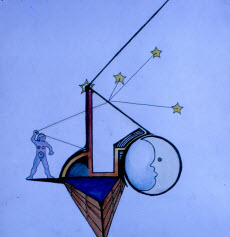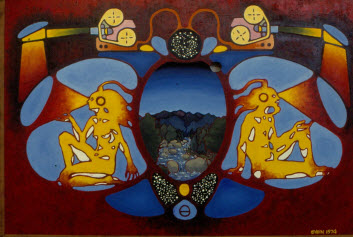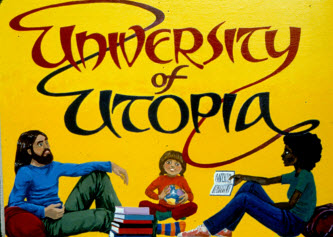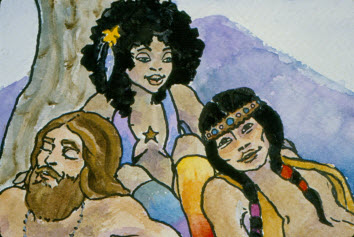Kerista Menu
|
The Dark Side of Community: Hidden Limits to Lasting Groups by Nu Luv [communal pseudonym] copyright © Nu Luv 2015
"99 percent of the time humans have lived on this planet we've lived in groups of 12 to 36 people. Only during times of war, or what we have now, which is the psychological equivalent of war, does the nuclear family prevail, because it's the most mobile unit that can ensure the survival of the species. But for the full flowering of the human spirit we need groups, tribes, community."
-Margaret Mead
"Every group shadow wears at least two sets of masks that deflect attention from the deeper issues. One set usually appears shiny and bright: uplifted faces seeking light, hearts yearning to beat as one. The other is often sharp and menacing: scowling faces, fingers pointing in blame....The shadow, by its nature, is elusive and hidden. It lives beneath conscious awareness in the dark alleys and underground tunnels of the personal and the collective psyche."
-Carolyn Shaffer & Kristin Anundsen, Creating Community Anywhere: Finding Support and Connection in a Fragmented World
[Author's note: I ask the reader to bear in mind that I am but one of dozens of participants in the Kerista community and what I share is merely my own story and viewpoint. In focussing on the shadow side my picture of Kerista may come across as skewed and unduly negative. This article was written in 1995 and appeared in various forms in 'Communities Magazine' and 'Loving More Magazine'.]
Losing My Community to the Shadow
In November 1991 the Kerista community, perhaps the most vibrant and promising experiment in polyfidelitous living in the latter part of the 20th century, self-destructed. Kerista was founded 20 years earlier and I was part of the community for its last 11 years. I was saddened, astonished, shocked, dismayed, confused, angry, grieving, perplexed, and...relieved. As I have tried to learn the lessons of this experiment and make sense of my involvement I invariably turn my attention to a significant and often disturbing arena which is often overlooked by idealistic community pioneers and explorers: the shadow side of community.
Put simply, the shadow side refers to the set of behaviors and attitudes which are hidden, covert, secret, unconscious, destructive. The shadow side deals with fear, pain, divisiveness, projection, and confusion. Robert Bly, paraphrased and quoted in the book Creating Community Anywhere, relates that "our shadow is the long, invisible bag we drag behind us filled with the parts of us that parents, teachers, and peers do not like. 'Since the...bag is closed and its images remain in the dark, we can only see the contents of our own bag by throwing them innocently, as we say, out into the world.'" Community life magnifies the shadows of the individual members. Bly's "long, invisible bag" is bulkier than the sum of the shadows of the people involved. The group shadow takes on a life of its own and can overwhelm a community if it is not consciously and effectively experienced.
As I prepared to write this article I re-lived (in my memories) the hellish side of my former community. My attention focused on experiences and situations that were so difficult and "unlike me" that I was dumbfounded that I became attached to that environment. I lost touch with the idealism, desire for personal growth, excitement and spirit of adventure that drew me to this community. In my mind, Kerista turned into a cesspool of insensitivity, megalomania, debauchery and childishness. It became apparent very quickly that as I struggled to shed light on the shadow, the shadow threatened to swallow up all of the light. Then as I pushed away the shadow and emerged into the light it became all too easy to rationalize the inappropriate behaviors and forget that there was a shadow.
Clearly, the truth was somewhere in between, , or, perhaps more relevantly, the truth is large enough to encompass both extremes of memory and behavior. A truly balanced picture of my community's life and history seems so elusive. I am tempted to shy away from discussing the specifics of our group's shadow. Yet, I am convinced that the only way to incorporate the shadow is to fully acknowledge it. How did I move from the satisfaction of joining a community that appeared to match all of my convictions, hopes, dreams, ideals and desires to awareness of a shadow side that was a covert power-craving cult at its worst? And, why did I stay until the very end?
Exploring Community as an Alternative Way of Life
I had a very happy childhood that was pierced by the untimely death of my father when I was fifteen. I reached a point of personal transformation mid-way through college at the University of Pennsylvania in Philadelphia. I was an academic achiever and had been propelled toward a professional career and monogamous life by my family and by the images of success projected by the surrounding culture.
I began to feel very dissatisfied with the lack of meaning in my projected future life. And, I disliked the dorm and frat scenes of college life, yet feared social isolation if I failed to conform to these norms. My emotional life was dominated by a waning relationship with my high school sweetheart and I had established few meaningful friendships up to that point. I was facing depression as my relationship ended and my anticipated future felt inadequate. Prior to my junior year some new friends wanted to form an off-campus group house and invited me to join them.
I loved living in the group house. My new friends became close friends. There was always someone to talk to or play with. We had meals together every weeknight and I met a lot of new people through these friends. I began to believe that just as I had stepped out of traditional college housing and found an alternative that fit me better, I would also discover more fulfilling lifestyle and career paths. I subscribed to Communities Magazine (Loving More did not exist at the time) and began to read as much as I could about intentional communities and alternative lifestyles.
I vacationed on the west coast during the summer of 1979 and gathered all the information I could find about alternative lifestyles. I read two magazines, Utopian Eyes and The Storefront Classroom ,that were both published by a community called Kerista in San Francisco. The writers described a lifestyle that included group marriage, shared parenting, total economic sharing, a group growth process, and a utopian plan for improving life around the world by replicating their model of community living. Though I was uncertain about whether or not the publications were works of fiction, I fervently hoped that the community they depicted was authentic.
Over the next year I wrote a few letters to the Keristans as well as other communities that seemed interesting. My intrigue with Kerista increased as I fantasized about what it would be like to experience family life with many lovers, no jealousy, deep camaraderie with the men who shared these lovers with me, and to be fully immersed in a vibrant intellectual and artistic lifestyle. I learned more about Kerista as I received letters and more literature from some of the members. Meanwhile, most other communities I wrote to seemed lackadaisical about my interest, did not have much in writing about their lifestyle, and casually suggested that I visit.
The Light Side of Community: Joining Kerista
One of the Keristan women, Lora [I will be using assumed names throughout this story], gave a talk at my group house while on a visit to Philadelphia. Several of my friends challenged her claims to a utopian lifestyle and could not believe that her community was reasonably free of problems, as she contended. My personal agenda for this talk was to observe the degree of independence of this woman as well as her overall vibe. I liked Lora a lot, thought she was quite intelligent and level-headed, and was attracted to her. So, this experience heightened my excitement and I felt that I now had a friend in Kerista.
In the summer of 1980 I visited Kerista on another California vacation. I first attended the "Growth Co-op," a discussion group open to the public that the community hosted in a Haight/Ashbury storefront. The room was decorated with homemade art including paintings of rural paradises, inspirational placards with groovy lettering, and a big colorful banner proclaiming "It's Happening!" The conversation was free-wheeling and intelligent and zipped through a wide range of subject matters. Though I had the self-image of an Ivy League intellectual, I had to focus intently to keep up with the flow. I was impressed with the nimbleness and creativity of thinking in the room. I asked if I could stay the night to continue talking about the community, and my request was granted.
Some of us retired to a nearby apartment (one of four flats rented at the time by the community). I stayed up late speaking with a few of the Keristans about their utopian lives, and my life, hopes and dreams. These people seemed to have a very clear idea of how to find friends attracted to their ideals. They were very social and easy to converse with. I felt right at home in their apartment. Homemade paintings, drawings and batiques that were all quite vibrant and attractive adorned the walls and all of the rooms had shelving that bulged with books and records. The description of Kerista as a place to experience "depression-free beautiful joy 24 hours a day" that I found in one of their magazines appeared to be matched by the friendliness, ease, and upbeat demeanor of the members. I felt like I was in a hippie paradise and I wanted to come closer.
I visited again a week later and stayed for three days. I participated in several activities including a large group meal (18 people), a trip to the circus with several community members and their two very young children, food preparation, and more discussion groups. Some of the Growth Co-op evenings included frank confrontation of disagreements and observations about personality flaws. During my last evening with the community one of those encounters briefly focused on me. Two of the members felt that in spite of my enthusiasm I was a dilettante (they had to define the word for me) and not deeply serious about community. Although I respectfully differed with their input, it was food for thought.
These first written and social contacts with the Keristans felt overwhelmingly positive. I had discovered a resonant community that shared my interest in changing the world and had developed a very appealing lifestyle. I was impressed with the ability of the group encounters to challenge people and provide insight. Although I was fearful about discussing these potential changes to my life path with my relatives and also doubted whether I would be truly accepted in the community, I forged ahead with my exploration. Returning to Philadelphia for my senior year, I started a discussion group called the Holistic Lifestyle Exploration Circle, enrolled in a history seminar called "Utopian Studies," read all the back literature I could about Kerista, and corresponded with most of the members. I inquired about problem areas in the community and was met with reassurance, coherent explanations, and, occasional gentle confrontation when I expressed doubts about aspects of the lifestyle. It was a period of soul-searching as I explored the parts of myself that were fearful of this type of life.
By the time I graduated college in 1981 I was ready to move to San Francisco and either join Kerista or develop a sister community if, by some chance, I did not fit in. If all else failed I could always pack it in and go to law school. Many of my close friends and, particularly, my mother, had expressed significant concerns about my direction. The Jonestown mass suicides had recently been in the news and several people feared that Kerista was a cult and that I was preparing to give up my freedom of thought and action. I assured them that I had thoroughly investigated Kerista and found it to be so strongly based on equality, democratic decision making, and personal freedom that it exhibited no resemblance to a cult. It was pointed out to me that Jake, one of the founders, possessed the deep booming voice, personal charisma, flowing gray hair and beard, and physical bulk often associated with the guru caricature. I had noticed these aspects of Jake's appearance, but had not seen evidence of special privileges during my visit. I was assured by the members that he was not their leader.
I believed that I was approaching Kerista with my eyes wide open. I was convinced that I could experience tremendous personal growth and work with my friends to develop a prototype community model that could greatly benefit the world. I was satisfied with my two-year exploration and was ready to settle in, find my family, and enjoy my new life.
On my first full day in the community I was invited to enter into courtship with the Purple Submarine, an eight-year group marriage that included 13 of the 16 Keristans (including eight attractive women). I spent the day excitedly talking with a number of my new friends. I observed a confrontation with a man who seemed emotionally withdrawn from his partners (he was voted out of the Purple Submarine after a long encounter) and another man rejoining the community after a three-month probationary period for some violation of the rules. At dinner time several people came home from work and most of the community was gathered.
At some point I was asked to describe my thoughts on the day. I was very impressed that so many members had participated in the conversations and encounters. It seemed ironic that my mother and some of my friends thought that I was entering a cult since I was witnessing a profound level of shared leadership rather than the domination of a guru. I blurted out the word "Cult..." and before I could continue my thought Jake interrupted: "Cult! He studied us for two years and he thinks we're a cult!! He has no business being in our family, much less the community." When I tried to explain that I had more to say and was actually trying to express the opposite opinion, several people told me I was being defensive. I soon stopped and listened to their input. It seemed that everyone jumped into the conversation and a few of my new friends suggested that I had said "cult" because I was something of a mama's boy and was not acting as an independent adult.
As I reflected on the input I felt that it had, indeed, pierced my surface persona and hit on one of the areas in which I needed to grow. Though I was no longer in courtship with the Purple Submarine I convinced the assembled masses that I did not see them as a cult and that I really really wanted to be in the community. I was so convincing that I stayed for the next 11 years, until Kerista dissolved in 1991. Only my deepest intuitive self was aware that on this first day in Kerista I had observed and supported one of the strongest aspects of the community's shadow. I fit the membership profile even better than I hoped on my first full day as a Keristan.
More Sunlight than Shadow: My First Five Years in Kerista
I loved my first years in the community. My artistic expression flourished as I wrote songs, poems and articles, played guitar, made documentary movies of community life, and produced comedy skits for holiday performances. My sixteen new friendships were very warm and exciting. I spent at least six hours each week with the children (ages two and three when I joined) and loved them dearly. There was a steady stream of interesting people in our lives: aging hippies who had been involved in the old Kerista Tribe that spawned the current community, people attending the Growth Co-op to examine our lifestyle, kibbutz pioneers from Israel, friends and relatives, and scholars from a variety of academic disciplines. I gave presentations to college classes about our lifestyle and appeared with other members on several local television talk shows.
My love life was outstanding. After my truncated courtship with the Purple Submarine I was quickly invited to be part of a smaller group marriage (called Jubilee) that was just forming along with Lora, who I had liked so much in Philadelphia, Zena, a very attractive and bright woman, and Leaf, a warm and intelligent man. The four of us stayed together for nearly two years, though at times other folks joined our family for short periods and then left. There was a considerable interpersonal drama in the community, usually concentrated in the Purple Submarine. Several people left Purple, formed new families or tried out our family (or both), re-merged with Purple, left again, and so on. Our group was calmer. We discussed the rough edges of our personalities as they emerged and were generally adept at suggesting techniques for each other to work on ourselves. I genuinely loved Lora and Zena (as well as Leaf), so my experience was in keeping with our strict polyfidelitous ideology. All of my familial relationships were indeed primary and equal [but not the same!].
I experienced some interesting twists and turns in my work life. When I first arrived, I became part of the home services collective and worked as a housecleaner and gardener. After six months of this I took a word processing class and in 1982 got my first job in the computer field. Over the next two years I moved from word processing into database management and programming, then became a computer consultant. I spent some of my free time working with the two Keristan administrators to computerize their bookkeeping and basic business systems. I also desktop published a lot of the community's' writings, and trained everyone in Kerista on computers who wanted to learn.
After two years my family merged with the Purple Submarine which, at that point, encompassed all but two people in the community. I was very excited that I was closer to these delicious new women and great guys. Yet, I felt less comfortable, in the Purple Submarine. Several members had a very confrontational style during group encounters. In Jubilee we tended to be patient during our group sessions (called gestalts) and give people space to discuss their feelings and ponder the input they were receiving. Gestalts within the Purple Submarine had a rapid-fire quality that could become rabid at times. People became passionately upset by character flaws and tirelessly endeavored to penetrate the defensive armors that each of us tended to erect to deflect painful truths about ourselves. Or so it seemed at the time. Gestalts generally lasted for hours and sometimes for most of a day or night.
Jake habitually dominated group conversations and determined our overall ideological direction. He exuded tremendous confidence and either considerable wit and jollity or intense disapproval and scorn, depending on his feelings and needs at the time. Jake did not have an outside job or defined internal work role. Instead, he played the part of chief theoretician and spent his time reading, hanging out, and working on essays, tracts and other writing projects that described the direction and merits of our utopian vision. Despite our commitment to equality, we all tended to flow with his style, and considered Jake to be an intellectual genius whose message needed to get out and be heard. We managed to fit his role within our vision of equality by agreeing that everyone had their own areas of strength and that each of those areas was fundamentally equal. My feelings vacillated between appreciation of Jake's mind and his role in founding the community and displeasure at the intensely negative comments that he often introduced during gestalt encounters. Living in a family with him was a significant challenge for me.
Six months passed and I left Purple (but not the community) for three months, then rejoined and stayed for another year. During my time away from Purple I missed being intimate with many of my lovers (Lora, Zena, and a few of the new women with whom I had developed a lot of affection) as well as the quick-witted intellectual flair of the group. Though I was not so in touch with my discomforts, I know that I felt guarded about fully expressing my feelings in Purple. I was also wary of the different pace of growth of my various relationships. Some of my newer lovers seemed uncomfortable with the depth that I had with the longer term relationships, particularly with Lora. So, I was gestalted at times for not experiencing an equality of feelings with my lovers. I was also gestalted for not gestalting other people enough. This was seen as a sign of emotional withdrawal. Though I was confused by my behavior, I know now that I withdrew into non-verbality at those times because some of these gestalts seemed unjust and insensitive and I was afraid to challenge the group lest the gestalt spotlight shine on me.
When I left the Purple Submarine for the second time, Lora and Leaf were also leaving and we formed a new group marriage, called Sanity Mix. Several new members had joined Kerista in the past year (after a three year drought that followed my entrance) and some of them joined our group. I found myself falling deeply in love with two of the new women, Rita and Ronnie, so I experienced a period of contentment in my intimate life as I settled in with them and continued to deepen my relationship with Lora. Sanity Mix had a stable core of five or six (there was a lot more turnover than Jubilee) for its three-year life, and retained much of the original Jubilee mellowness.
The community's quaint $100,000 per year home services business was to go through dramatic changes from 1985-87. Our unplanned growth began when we opened a computer services branch (desktop publishing and database consulting). A few members then setup a printing brokerage and within a year our revenues had tripled. We then managed to secure a computer dealership from Apple Computer (we had become Macintosh fanatics) and through a series of clever sales moves, strong dedication to customer service, and a charmingly eccentric corporate image, our $300,000 business increased to $800,000 in 1986 and then $3 million in 1987! What this meant is that many of us (and eventually all of us except Jake and a handful of newer members) were spending more and more time at our jobs and less time enjoying our relationships, processing emotions and feelings, and just hanging out.
The Shadow Consumes the Light: My Last Five Years in Kerista
In the mid 1980s several of our members experienced personal problems that highlighted some of our dysfunctional areas.. Gina, the sweet and lovely mother of one of our girls, never emerged from her post-partum blues and became seriously depressed. Though we were deeply and genuinely concerned for her, the only therapy we knew how to offer was to gestalt her when she said things that were uncomfortable to hear. Gina had some experience as a psychological nurse and wanted to try receiving therapy or medication. However, she had to argue strenuously and undergo many encounters to get the blessing of our membership. Our psychological model held that if a person could not benefit through our process it meant that they must not really want to be with us.
During this same period Lora received a double shock when both of her parents became very ill and died within a year of each other. She took a week off from her job to grieve and within a few days Jake began to badger her to spend some of her time off upgrading our fledging business systems. The timing of this gestalt was not only strange, but cruel. When some of us weakly tried to encounter Jake's intensity he pushed harder and we all relented. Some months later he grouped three of us (myself included) with Lora as the obstacles to continued business growth and persuaded the group to vote (and enforce) a month of celibacy so that we would reconsider our priorities.
In the wake of these sanctions, Lora withdrew emotionally and lost her characteristic good humor. Lora was the soul of our family and her depression, in part, propelled Sanity Mix into crisis. Petty conflicts increased and we experienced more turnover of new members.
One of the major flaws of our lifestyle of polyfidelity became evident to me during the Sanity Mix period. Our conception of polyfidelity posited that all sexual relationships in a group marriage must be primary. A consensus was required for a new member to enter a group. For a woman to join, all men had to see the possibility of building a primary relationship and had to maintain a strong and growing attraction. (And vice versa when a man wanted to join.) In theory, if one or more people were not open to a prospective member, then the group closed to that person. Problems arose when some people were very attracted to a new member and others were not. There were many occasions in which peer pressure was exercised to resolve this type of situation. The most assertive party or clique typically prevailed.
On at least two occasions I found myself agreeing to have women join the group that I did not feel particularly comfortable with. The first time I was trying to accommodate some of the other men and figured that if I did not begin to feel passionately about this woman in the first few months that I could bring the problem to the group. On another occasion, only two men (out of six) wanted a particular woman in our family, but several people outside of our group asserted a lot of persuasive efforts to get us to give this gal a break. We succumbed to the peer pressure. Within a week, this woman behaved oddly in some context and during the ensuing gestalt enough pressure was exerted on her, in the form of intense input, that she ended up withdrawing from the group.
As Sanity Mix began to break apart from these pressures (Ronnie, as well as several other new members left the community) we were invited to join an experimental merger into the Purple Submarine that was proposed to try and save the community from disintegration. I have always suspected that it was also motivated by the desire of some of the men in Purple to sleep with some of the women in Sanity Mix, since the women in Purple were not very keen about the idea. I also had significant misgivings, but after Lora and one the other remaining woman in Sanity Mix consented I decided to give it the old college try. My alternative was to cut myself sexually off from all of my lovers.
I had grown in confidence over the years, so I fit in much better with Purple. However, Lora was clearly withdrawn from me, and, after a brief honeymoon period she withdrew from the entire community. Two other long-term members and one very popular newer man also left at this time. Since there were some bright new people who had just joined, we managed to carry on without total demoralization. However, many of us were in shock and in some ways Kerista never recovered.
With our computer business reaching $3 million a year and no ceiling in sight, all but one person with jobs on the outside began to work full-time for our company. The work week for most of us expanded from 32-40 hours before 1985 to 45-60 in the 1985-87 surge to 70 and more for the next four years. Although there was a giddy excitement and sense of pride that kept us going as we soared to $10 million in revenue in 1988, $15 million in 1989 and $30 million the next two years (by now the reader should have guessed that I was the chief financial officer), we were in way over our heads and the pressure was tremendous. There were profits some of those years, but the company ran out of control. We did not hire outside staff until 1988 and had nearly 100 outside employees plus 20-30 of us from the community on payroll by 1991. Beginning with very little capital, we survived on credit and increasingly large bank loans. When the computer industry was young and roomy we held our own. However, in 1990 the industry changed dramatically and our inexperience began to catch up with us.
In these four pivotal years of business obsession many of us reached our 30s and developed much more personal confidence. Meanwhile, Jake was behaving more erratically. Anticipation and management of his dark moods and tantrums became commonplace. The more our business grew the harder Jake pushed and the less relevant his own small business experience seemed. His role was primarily one of brainstorming and informal review of our numbers. Yet, due to our community agreements, all decisions made by our managers were subject to challenge by the membership as a whole. In practice, most of the community trusted our management team (consisting of five or six members). Yet, there were frequent occasions of limping home after a draining 12-14 hours in the office and being encountered by Jake who on his best nights would want to pick our brains and manically discuss how to become a Fortune 500 company and on his worst nights would berate us for real and imagined failings of our operation. And, Jake had a knack for exhorting one or more of our colleagues to mimic his anxieties, so late-night business gestalts were frequent.
One of our fundamental social agreements in Kerista was to be totally accountable for our actions and words and to be honest with each other at all times. As the years went by and our personal growth and encounter sessions stultified into predictable castigation exercises this presented a terrible dilemma. I knew that I was increasingly dissatisfied with the way we conducted our lives. Yet, I was convinced (based on countless observations over the years) that if I expressed my distaste as strongly as I felt it, I would quickly find myself the target of all the group's pent up frustration with the same situation. Most likely, I would end up being expelled from the community or voluntarily withdrawing to end the verbal assault. I was so emotionally invested in my friendships and sexual relationships that I could not bring myself to lay it all on the line. So, I learned to rationalize the flaws and keep many of my dislikes to myself.
Somewhere in the late 1980s I began to have occasional, halting conversations with a few of my lovers about our dissatisfactions. There was much fear and confusion at that point and we were all quite overwhelmed by our business responsibilities. Still, it was good to have a small outlet for honest communication. In 1990 and 1991 there were two large group camping trips that did not involve Jake. We spent many evenings around the campfire agonizing about the disappointments and unkindnesses of our lives. there was more honesty about these issues and problems expressed than at any other time in our community's history. We also spent many hours harshly gestalting two of the women in our family during one of those trips for acting disinterested in some new guys that some of the women wanted in our group. There was some attempt to strategize and figure out how to get back to our ideals of equality and a desire for an effective growth process without major confrontation of Jake.
There was not much progress on these desires, yet there was more and more talk throughout 1991. Finally, one of the long-term members of the Purple Submarine came to us after a tearful encounter with Jake and said that she was on the verge of leaving the community and building a gentler and saner life for herself. She was saddened at the thought of not being with us and she was very serious. One of the other women exclaimed that the situation was absurd and that if we were interested in justice than we would finally hold Jake to the same standards we lived by and he would either submit or leave the community.
And, that's exactly how the end came about. Ten or eleven of us agreed that the next time Jake threw a tantrum and tried pushing for the expulsion of a member from our family we would all oppose him and stand our ground. This happened within two weeks. After he was challenged in this manner, Jake spent several hours trying to enlist the support of everyone he could reach. When no one took his side, Jake withdrew from the Purple Submarine but stayed in Kerista. The next three days were a free-for-all as most members freely approached Jake with their feedback without fear that he would counterattack and amass enough support from the community to squash their views.. The overall aim was to all live by the same code of behavior instead of the double standard in which criticism of Jake's behavior resulted in serious consequences and criticism of other members tended to be heard and supported. Jake left the community within a week after he was challenged.
We were all stunned and many were exultant. The business problems kept piling up and we now had to figure out what to do next as a community. A few days after Jake left we shared our last Thanksgiving together, then agreed to meet weekly as a community to discuss the future. At the first of these meetings one of our more assertive members made an appeal to disband the community on the grounds that we were all so hurt and confused by years of stress and craziness that we needed to make a fresh start. After very little discussion she called for a vote on her proposal. We reacted to this strong appeal by an assertive person in the typical Keristan fashion. We agreed unanimously and dissolved the community effective December 31, 1991.
Understanding the Shadow
Now that I have invoked the shadow of Kerista for the month that I have struggled with this article and have offered the reader a glimpse of its more egregious components, I need to highlight some of the vital lessons. Creating Community Anywhere by Carolyn R. Shaffer and Kristen Anundsen is an outstanding resource. The authors share some keen insights about community living. According to Shaffer and Anundsen, the shadow side of a community will manifest in several common guises, including the Harmony Trap, the Equality Trap, and Hidden Agendas and Power Plays. I see evidence of each of these pitfalls in my observations of the Keristan shadow. [All quotes below are from Creating Community Anywhere unless otherwise noted.]
The Harmony Trap. "Holding harmony as an ideal is not the problem. the danger lies in ignoring the process that leads to harmony and that maintains it after it is attained." The authors explain that emotional toxins will build up within a community (or person) that pretends it is always in harmony. These emotional toxins make the community "vulnerable to depression, fear, or rage among its members and death by slow attrition or sudden breakdown."
In Kerista we consistently proclaimed to the world and ourselves that as a model utopian society we were remarkably free from strife. We proudly crowed that no one ever experienced anger or jealousy in our midst. However, guests often commented that our gestalt process was unduly harsh and challenged our claim to have conquered unpleasant emotions.
For most of my years in Kerista, members rarely expressed harsh emotions outside of our gestalt sessions. Group encounters were the arena in which we vented frustration and rage. The ferocity in which input was transmitted was often an outlet for the unexpressed anger of the participants. And, as Shaffer and Anundsen surmise, the build up of emotions resulted in depression and withdrawal among some long-term members and hastened the death of the community by unexpected breakdown. Declarations of communal peace, love and harmony rang more and more hollow over the years. The illusion of harmony was replaced by a gradual, then sudden realization of how divisive and manipulative we had become over the years.
The pent-up rage that was expressed toward Jake during his last week in the community was the tip of an iceberg that including self-loathing and recrimination toward our partners in community who had also been our partners in emotionally abusive behavior toward one another. The will to maintain a community was broken by the magnitude of our group and individual shadows.
The Equality Trap. Communities often operate on the assumption [in Kerista this was explicitly stated] that all members possess equal amounts of power. Members can feel uncomfortable about differences that arise and choose to downplay them to maintain the politically correct appearance that everyone is equal in all respects. "Problems arise, as with the harmony trap, when the gap between the ideal and the real widens to the point of creating resentment or disillusionment among community members."
One of our most cherished standards in Kerista was total equality. Gender, age, race, economic background, and ethnicity were all seen as "equalitarian variables." Within the community none were to enjoy special privilege and all were to exert equal amounts of leadership and enjoy equal standing in our friendships and sexual relationships. We criticized our lack of shared leadership at times, and at other times we reveled in the belief that we were much more advanced than any other group in this regard.
It was very difficult for our members to acknowledge that the most aggressive individuals, and Jake in particular, wielded tremendous power during gestalts. Jake also dominated group conversations. In later years the business management team held much power since the business became the foal point of the community. We vehemently denied all assertions that Jake was the de facto leader or guru. My first day in the Kerista, when I uttered the word "cult" and was heavily gestalted, was certainly a sign of the community's sensitivity around this issue. Given the Jake's dominance in developing our ideology, his dominance of conversations, and his ability to manipulate by using gestalts and other tools, a case can be made that Kerista was a cult and Jake the guru. Whether or not this is so, our failure to live up to our standard of equality damaged the spirit of our members. And, at the end, when Jake's power position was squarely challenged and he withdrew, resentment, disillusionment, and our habit of going along with voices of authority, hastened the death of the community.
Hidden Agendas and Power Plays. One of my good friends left Kerista five years before the end. He talks about "the invisible empire" that existed below the surface. This empire consisted of the unacknowledged social and political heirarchy that existed in the community. Consistent aggressive behavior would win a person a spot near the top of the pecking order. Membership in the Purple Submarine was also a key to power in Kerista. Many of us gravitated toward Jake, in part, to be near the center of power in the community.
Though I am no therapist, it is easy to guess that many other games that were going on below the surface. Sexual motivations played a major role in our encounter sessions. If someone was not comfortable being lovers with a person, one way to get out of the relationship, without having to discuss the discomfort, was to escalate the gestalt by making a big deal out of small issues. When skillfully done, this tactic could have a bandwagon effect and the person in the spotlight may crack under the pressure and withdraw from the group. In cases in which a person wanted to stay with a person in the center of a gestalt, they could work hard to mitigate the situation and give the person cues to make easy admissions so that the encounter could be resolved with too much mess. There were many variations of this single theme and it is mind-boggling to contemplate the innumerable variations of mind games that were being played out in the guise of personal growth or to protect the sanctity of our utopian model.
Claude Whitmeyer in his book In the Company of Others: Making Community in the Modern World , discusses a recurrent predicament that many communities experience:
"In its more benign manifestations, the collective shadow is most commonly exhibited as mindless conformity. Many communities exist today in which members conform to the expectations of the group, rather than taking the inner journey of self-discovery, including the recognition and reowning of the shadow, which could make them better contributors to the common good. Fears and superstitions keep us locked into acceptance of standards of behavior that are determined by someone else."
In order for members to avoid or grow beyond peer pressure it must be safe to express feelings and grapple with problems on the personal, interpersonal and group level. Confrontational processes, in their many forms and structures, can be powerful tools for delving into the psyche and achieving profound insight into the shadow. Encounter groups can also be misused and turned against the individual for the sake of manipulation and coercion. A good protection against misuse is to develop an array of tools for use in exploring the shadow.
I have realized with some amusement, that adoption of a gestalt process by Kerista was the equivalent of building the first hammer. It was a magnificent tool for working with nails. A hammer will work on screws, but it takes a lot more banging and is not entirely satisfactory. And, when we attempt to polish a window with a hammer all we will get is broken glass. The problem at Kerista is that our gestalt hammer worked so well when it was first tried that the community adopted it as a panacea and persistently used it in every situation. Had we filled in our toolbox with group silence and receptivity so that an individuals could speak their hearts, used mediation to help resolve disputes, ritual to help us through painful experiences, and even traditional therapy to help guide us through individual crisies, we would have built a more solid foundation. With gestalt as our only tool, we evolved a fear-based environment and conformity became the main survival mechanism. As we nurtured our shadow with fear and the parallel build-up of unexpressed feelings and emotions, we neglected to nurture our heart. At the moment of our potential liberation and healing we could not sustain the will to survive as a community.
Lessons for Seekers and Communities
I firmly believe that intentional community addresses many significant needs and problems of the individual and our troubled society. Communities can be very healthy and good at achieving balance between the needs of the individual and those of the group. They can also be very dysfunctional and sap the spirit of their members. It is vital that individuals seeking community make wise assessments as they contemplate a commitment to others and the hope that this will take them through their lifetime.
While research and reading about a community are important in checking it out, the most important experience will be conversations. The best tools are well-conceived questions and very sensitive listening. Carefully question any community in which you are seriously interested. Realize that utmost respect is required in your questioning, as you may be touching on very sensitive areas. Here is a beginning list of questions that comes to mind:
What are the key problems and dillemmas that you experience in your community?
What are the key problems your community has resolved over the years, and how was this accomplished?
How does your community handle fundamental crises, like major discomforts of one or more members with growth processes, decision making, power structure, etc.? In other words, how are major changes made in your community?
What kinds of power and leadership issues has your community experienced?
How are major decisions made? How about smaller, day-to-day decisions?
What are the methods used for resolving conflict in the group?
Have members ever reported feeling that they were coerced or manipulated into going along with a decision?
What growth processes or techniques are used by your community as a whole?
Are any growth techniques based on group or individual encounter (gestalt)? If so, how are encounters initiated? Does the individual in the spotlight have a right to terminate an encounter without negative consequence?
Can a person freely leave your community? What types of economic agreements are in place for this situation? Is contact between current and ex-members restricted in any way?
Have long-term members (more than one year) left your community? If so, why? Can I contact any of them?
Is contact between community members and people in the outside world (friends, relatives, etc) restricted in any way?
Is there active animosity between your community and any ex-members?
Has your community ever been accused of being a cult? Why? Do you agree?
What types of criticism has the community received from people who have not joined or from outside observers?
How are sexual relationships determined? Is sex a private matter, left to the individuals primarily involved? Do people need permission to either sleep with someone or not sleep with someone (other than individuals with whom they have a direct commitment, such as the partner(s) in question)? How much involvement does the group have?
What level of commitment does your community have to the individuals involved? If someone experiences psychological or physical problems, or when they become old and infirm is there a provision for them to stay in your community?
What principles must a person agree with to be a member of your community? What level of commitment is there to the person if she or he begins to question these principles?
Is there a forum for exploring the community's shadow and finding ways to heal the hurts that arise in community?
As I mentioned, it is important to spend some time discussing these questions with a variety of community members in person. You will learn a lot more if you can also observe body language, emotional expression, and overall vibe. After such discussions, spend time by yourself and reflect on the following questions:
Did the members seem to answer my questions freely? Were they evasive, defensive or hostile at any point?
Did the members actually describe significant problems, or did it seem that the were trying to deny, minimize, or rationalize their problems? (Do keep in mind that interpersonal problems can be embarassing to discuss with a new person.)
Did you feel respected by and comfortable with these people in your discussions?
Did you get similar answers (as opposed to identical or wildly differing responses) from various members?
Did you have the impression that members spoke freely in the presence of their peers?
After talking with these people, do you have a coherent picture of the shadow issues that they experience in community and how they handle them?
What does your deepest intuition tell you about these people and their community?
For communities:
If a person expresses a serious interest in joining you, you must fully disclose your issues and problems as well as your history of issues and problems. (Dirty laundry is not necessary in public, but is absolutely vital for someone contemplating a commitment.) It totally sucks to get a person all emotionally and otherwise entangled and then drop bombshells on them. the same holds true, really, for any committed relationship. If you are not willing to disclose these things then (a) you risk doing great harm to a person innocently checking out your scene; (b) you run a greater risk of accepting someone who doesn't really fit--they have to be able to accept the good and the shadow; (c) you degrade your group dynamics by collaborating on unethical behavior.
Resources:
Different Drum, M. Scott Peck
Creating Community Anywhere
The Shadow Side
In the Company of Others
Collaborative Communities
| |









